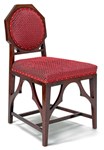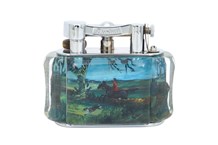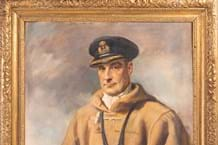
Sculpture was one of the one of the categories in the spotlight in Paris sales over recent weeks whether in the form of a Renaissance marble lamb, a late 19th-early 20th century mythological subject, a 1930s bronze stag or a 1970s oversized duck.
Much the highest price in a sale of paintings, sculpture, furniture and works of art held by L’Huillier (28% buyer’s premium inc VAT) at Drouot on April 2 was the record-breaking sum paid for a 1930 bronze by the French animalier sculptor François Pompon (1855-1933).
His Grand Cerf, a sand-cast rendition of a large standing stag, eclipsed its €80,000-120,000 estimate to sell for a hammer price €620,00 (£539,130) or €793,599 including premium. The price set a new auction high for Pompon, beating the previous high of €607,500 including premium paid in 2014 at Christie’s Paris for a 1925 cast of a tigress.
Pompon’s majestic large stag was originally conceived in 1929 for an industrialist for his property in Momères. The sculptor then went on to produce a further smaller-sized edition of 10 measuring 2ft (60cm) in height the following year using the same foundry, Andro.
The cast offered by L’Huillier is signed on the base and numbered 1 in this edition. Its last appearance at auction was in 1964 at a sale held by Ader at the Palais Galleria where it was acquired by the family of the vendor.
Venerated lamb
The Renaissance marble lamb, which featured in the same sale, took the form of a 16½in (42cm) high naturalistically rendered model of the animal.
Catalogued as Italian and dated to the 15th or 16th century, stylistically it references biblical depictions of the Pascal lamb and the light wear over the surface suggests it may have been an object of devotion.
The fact that the 12in (30cm) wide base is carved on all sides also suggests it was conceived as a standalone work rather than as part of the larger group.
There were some small areas of damage and loss and traces of old restoration to the head and tail.
It was estimated at €20,000-30,000 but more than doubled that level to take €70,000 (£60,870).
Dominant duck
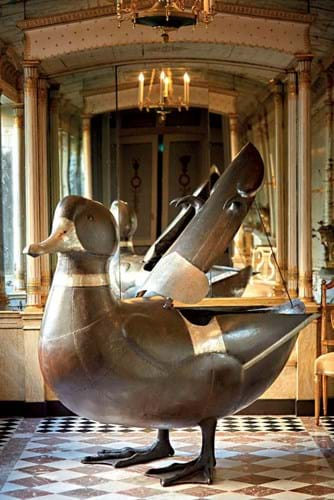
François Xavier Lalanne’s giant duck – €1.51m (£1.3m) at Gros et Delettrez. Image copyright: Gros-Delettrez/Drouot
A third sculptural highlight was an example of the quirky sculptural menagerie produced by François- Xavier Lalanne (1927-2008) and his wife Claude (1924-2019).
It was offered in a 58-lot sale titled The World of Decorative Arts held by Gros et Delettrez (30% buyer’s premium inc VAT) at Drouot on April 12.
Made from painted tôle and polished nickel silver, this was a model of a duck of monumental proportions with a head that swivels open and back that lifts up to double up as a receptacle for clothes or ‘jettes habits’.
It measures 6ft 10in (2.1m) wide and stands 4ft 7in (1.4m) high when closed and 5ft 2in (1.6m) when open and is a one-off piece by François Xavier from 1971, monogrammed FXL, stamped François X Lalanne and dated on the top.
The piece had a provenance back to a private French collection, acquired directly from the artist; a sale at Piasa in 2010; the Galerie Patrice Trigano, Paris and a private collection in Switzerland.
It sold for €1.51m (£1.3m) against an estimate of €800,000-1.2m.
Claudel depicts Perseus
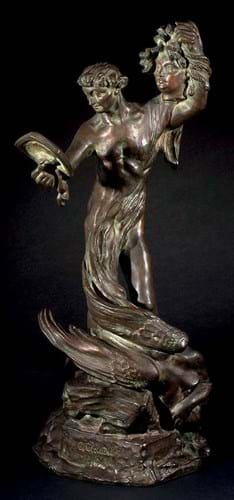
Camille Claudel’s bronze of 'Perseus and the Gorgon or Petit Persée' – €300,000 (£260,870) at Aguttes.
More recently a sale of Impressionist and Modern art held by Aguttes (25/23% buyer’s premium) at Neuilly near Paris on May 4 was topped by a hitherto unpublished bronze by the sculptor Camille Claudel (1864-1943).
Her rendition of the story of Perseus and the Gorgon in a 20 x 11¾in (51 x 30cm) bronze, also known as Petit Persée, sold for €300,000 (£260,870), the upper end of its estimate.
Claudel has shown the Greek hero Perseus after he has decapitated the Gorgon Medusa. Her head is held high above and behind him. He does not look at the snake-headed Gorgon directly, as according to the myth this would have turned him to stone, but via a reflection in a mirror given to him by Athena.
Claudel first approached the subject of Perseus and Medusa in monumental form. She produced a lifesize plaster cast that was exhibited in 1899 (no longer in existence although known from a photograph) and a marble version which was commissioned by her patron, the Comtesse de Maigret, for the entrance of her private mansion in Paris and was shown at the Salon of 1902.
Claudel also produced a smaller bronze version of her Perseus measuring around 50cm with slight differences to the large sculptures. It was cast by Eugene Blot in his foundry in 1905 and six copies were produced.
The version offered at Aguttes came from the collection of the Comtesse de Maigret and has passed down by descent. It was hammered down after a lengthy bidding battle and will now be joining a French collection.
£1 = €1.15



